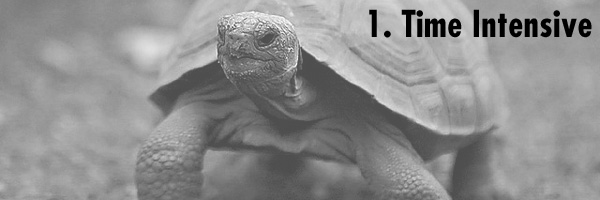There’s no such as thing as the perfect investment, as all investments have at least one negative quality that an investor must accept in order to realize the benefits of the investment. Dividend stock investing is certainly no exception. As good as dividend investing may seem, as covered in the Top 5 Advantages of Dividend Investing post, there are disadvantages and limitations that are inherent to this investment vehicle. Here’s my view on the unpleasant realities of dividend investing:
 Forget about dividend investing if you’re looking to “get rich quick.” Unless you’re making a LOT of money to begin with, dividend investing is going to be slooooow. If you’re starting from zero, it will take quite some time until you begin to see even a decent return on your dividend investments, regardless of how good the yield. For example, it has taken me nearly seven years to reach my current level of dividend income, and that’s with a mix of high to moderate risk dividend stocks with equally high to moderate yields.
Forget about dividend investing if you’re looking to “get rich quick.” Unless you’re making a LOT of money to begin with, dividend investing is going to be slooooow. If you’re starting from zero, it will take quite some time until you begin to see even a decent return on your dividend investments, regardless of how good the yield. For example, it has taken me nearly seven years to reach my current level of dividend income, and that’s with a mix of high to moderate risk dividend stocks with equally high to moderate yields.
The only way to minimize the time requirement is to maximize the amount of capital that goes into your portfolio (see item #2 below) and/or seek higher yield (and consequently higher risk) stocks. By doing this, your dividend income snowball will grow much faster.
Some dividend investors have accelerated their dividend portfolios by going ultra-frugal and attaining astounding savings rates of 60% or better, which enabled them to shovel more dollars into their portfolio to have their dividend snowball grow more rapidly.

Whoever came up with the saying “It takes money to make money” surely must have had dividend investing in mind. Whether you’re rolling money into your portfolio as fast as you can by going ultra-frugal or taking a slower and less intense approach, building a dividend investment portfolio that has decent payouts every month or quarter will require money. A LOT of money. Unless you have a phat stash of cash to start with and feel comfortable going “all in” with that money, then it will take some time (see item 1 above) for your portfolio to grow large enough to realize decent dividend payouts.
The mathematics are inescapable. For example, if your goal is to have an annual dividend income of $35,000 and your dividend stock portfolio has an average yield of 3.5%, then you will need $1,000,000 in capital to attain that income goal. If you already have a million dollars to invest, then great! You’re already there. Buf if not, then it will take time to build your dividend income portfolio. How much time depends on how much capital you have available to invest with. The wider the gap between your income and expenses, then the more capital you can raise and the less time it will take to reach your dividend income goal.

Buying stocks is a lot like being on a passenger plane. Once you’re aboard and the plane takes off, you’re just along for the ride and have absolutely no control over the flight. If there’s turbulence, bad weather, mechanical problems, or other factors that make the flight difficult or dangerous, your only option is to sit it out. As a shareholder, you’re exposed to market downturns, dividend cuts, stock splits, changes in payout frequency, interest rate changes, and an endless number of external factors that can affect your portfolio. Other than deciding when to sell a stock, you have no control over any aspect of the stock. Unless you’re a major shareholder, large institutional investor, fund manager, or other big player whose 8- or 9-figure choices can sway a company or fund, your lone shareholder’s voice is effectively non-existent.
These are the downsides to dividend investing, as I see it. Despite the negatives, I’m still glad that I began my dividend investing quest back in 2008. The only real downside has been the dividend cuts, which has made my quest a “4 steps forward, 1 step back” experience (Limited Control) and the amount of time and money it has taken to reach my current level of dividend income.

